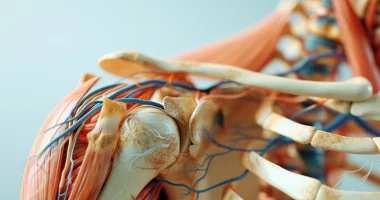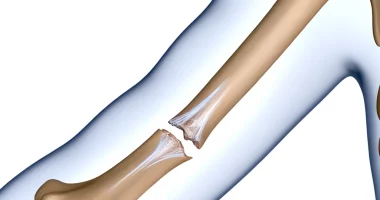Cerebral ischemia
Definition
Cerebral ischemia is a cerebrovascular insufficiency caused by progressive deterioration of the blood supply to brain tissue. The clinical picture of chronic cerebral ischemia consists of headaches, dizziness, cognitive decline, emotional lability, and motor and coordination disorders. The diagnosis is made based on symptoms and data from ultrasound of cerebral vessels, CT, or MRI of the brain. Therapy of chronic cerebral ischemia involves hypotensive, hypolipidemic, and antiplatelet therapy; if necessary, surgical tactics are chosen.
General information
Chronic cerebral ischemia is a slowly progressive dysfunction of the brain resulting from diffuse and/or small-focal damage to brain tissue under conditions of long-term insufficient cerebral blood supply. The term “chronic cerebral ischemia” includes dyscirculatory encephalopathy, chronic cerebral ischemic disease, vascular encephalopathy, cerebrovascular insufficiency, atherosclerotic encephalopathy, vascular (atherosclerotic) secondary parkinsonism, vascular dementia, vascular (late-onset) epilepsy.
Causes
Among the main etiologic factors are atherosclerosis and arterial hypertension, often revealing a combination of these conditions. Other cardiovascular diseases can also lead to chronic cerebral circulation ischemia, especially those accompanied by signs of chronic heart failure and heart rhythm disorders (both permanent and paroxysmal forms of arrhythmia), often leading to a drop in systemic hemodynamics. There is also an anomaly of vessels of the brain, neck, shoulder girdle, and aorta (especially its arch), which may not manifest themselves before the development of atherosclerotic, hypertensive, or other acquired processes in these vessels.
Recently, venous pathology, both intra- and extracranial, has been attributed to a major role in the development of chronic cerebral ischemia. Vascular compression, both arterial and venous, can also play a certain role in the formation of chronic cerebral ischemia.
Clinically detected encephalopathy is usually of mixed etiology. In the presence of the main factors in the development of chronic cerebral ischemia, the rest of the variety of causes of this pathology can be interpreted as additional causes. Identification of additional factors that significantly aggravate the course of chronic cerebral ischemia is necessary to develop the correct concept of etiologic and symptomatic treatment.
Additional causes of chronic cerebral ischemia include hereditary angiopathies, vascular compression, arterial hypotension, cerebral amyloidosis, systemic vasculitis, diabetes mellitus, and blood disorders.
Symptoms
The main clinical manifestations of chronic cerebral ischemia are polyform motor disorders, impaired memory and learning ability, and emotional disorders. The clinical features of chronic cerebral ischemia are progressive course, andstaging.
The core of the clinical picture of dyscirculatory encephalopathy is currently recognized as cognitive impairment, detected already in stage I and progressively increasing by stage III. In parallel, emotional disorders develop (inertness, emotional lability, loss of interests), and various motor disorders.
Stages of disease
- Stage I. The above complaints are combined with diffuse microfocal neurological symptoms in the form of anisoreflexia and coarse oral automatism reflexes. Mild changes in gait (slow walking, small steps), decreased stability, and uncertainty in performing coordination tests are possible. Even at this stage, mild cognitive disorders of the neurodynamic type are present: exhaustion, fluctuation of attention, slowing down, and inertness of intellectual activity.
- Stage II. It is characterized by increasing neurological symptoms and possibly forming a weakly pronounced but dominant syndrome. Complaints become less pronounced and not so significant for the patient. The fulfillment of tasks unlimited by time limits is disturbed, but the ability to compensate (the ability to use cues is preserved) is preserved. There may be signs of reduced social and professional adaptation.
- Stage III. Characterized by the vivid manifestation of several neurological syndromes. Walking and balance are impaired, urinary incontinence, parkinsonian syndrome. Due to decreased criticism of his condition, the volume of complaints decreases. Along with neurodynamic and dysregulatory cognitive syndromes, there are operational disorders (disorders of speech, memory, thinking, praxis), which can develop into dementia. In such cases, patients are slowly deadapted, which manifests itself in professional, social, and even everyday activities.
Diagnosis
Chronic cerebral ischemia is often characterized by the following components of the anamnesis: myocardial infarction, ischemic heart disease, angina pectoris, arterial hypertension (with kidney, heart, retina, and brain damage), atherosclerosis of peripheral arteries of the extremities, and diabetes mellitus. Physical examination is performed to detect pathology of the cardiovascular system and includes determination of the safety and symmetry of pulsation in the vessels of the limbs and head, BP measurement on all four limbs, and auscultation of the heart and abdominal aorta to detect heart rhythm disorders.
The purpose of laboratory studies is to determine the causes of the development of chronic cerebral ischemia and its pathogenetic mechanisms. A general blood test is recommended to determine blood sugar level and lipid spectrum. To determine the degree of lesion of the substance and vessels of the brain, as well as to identify background diseases, the following instrumental studies are recommended:
- EKG;
- ophthalmoscopy;
- echocardiography;
- Doppler ultrasound of the main arteries of the head and extra- and intracranial vessels;
- angiography of cerebral vessels (to detect vascular anomalies).
Treatment
The goal of treatment of chronic cerebral ischemia is to stabilize the destructive process of cerebral ischemia, to suspend the rate of progression, to activate mechanisms of compensation of functions, to prevent ischemic stroke (both primary and recurrent), as well as therapy of concomitant somatic processes.
Chronic cerebral ischemia is not considered an absolute indication for hospitalization if its course is not complicated by stroke or severe somatic pathology. Moreover, in the presence of cognitive impairment, removing the patient from their usual environment may aggravate the course of the disease.
Medical treatment
Drug treatment of chronic cerebral ischemia has two directions. The first is normalizing cerebral perfusion by affecting different levels of the cardiovascular system. The second is influencing the thrombocyte link of hemostasis. Both directions contribute to optimizing cerebral blood flow, which is carried out at the same time as neuroprotective function.
- Hypotensive therapy. Maintaining adequate blood pressure plays a major role in preventing and stabilizing chronic cerebral ischemia. Sharp fluctuations in blood pressure should be avoided when prescribing antihypertensive drugs, as the mechanisms of cerebral blood flow autoregulation are disrupted in the development of chronic cerebral ischemia.
- Hypolipidemic therapy. In patients with atherosclerotic lesions of cerebral vessels and dyslipidemia, in addition to diet (limitation of animal fats), hypolipidemic agents should be prescribed. In addition to their main action, they contribute to the improvement of endothelial function, reduce blood viscosity, and have an antioxidant effect.
- Antiplatelet therapy. Chronic cerebral ischemia is accompanied by activation of the platelet-vascular link of hemostasis, so antiaggregant drugs, such as acetylsalicylic acid, must be prescribed. If necessary, other antiplatelet agents are added to the treatment.
Surgical treatment
In chronic cerebral ischemia, the development of occlusive-stenotic lesions of the main arteries of the head is considered an indication for surgical intervention. In such cases, reconstructive surgeries are performed on arteries, supplying brain – carotid endarterectomy, stenting of carotid and vertebral arteries.
All these treatment options are available in more than 350 hospitals worldwide. For example, Carotid angioplasty and stenting can be performed in 17 clinics across Turkey for an approximate price of $8.2 K(https://doctor.global/results/asia/turkey/all-cities/all-specializations/procedures/carotid-angioplasty-and-stenting).
Prognosis and prevention
Timely diagnosis and adequate treatment can stop the progression of chronic cerebral ischemia. In case of severe course of the disease, aggravated by concomitant pathologies (hypertension, diabetes mellitus, etc.), the patient’s ability to work is reduced (up to disability).
Prophylactic measures preventing the occurrence of chronic cerebral ischemia should be carried out from an early age. Risk factors: obesity, hypodynamia, alcohol abuse, smoking, stressful situations, etc. Treatment of such diseases as hypertension, diabetes mellitus, and atherosclerosis should be carried out exclusively under the supervision of a specialist.

